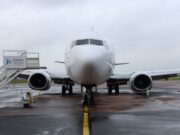Establishing “committed-to-stop” points on landing for turbine airplanes and allowing pilots to use prescription sleep medications to counter insomnia were among the recommendations generated by the investigation of a Hawker 800A accident in Owatonna, Minnesota, U.S., that killed all eight people aboard and destroyed the airplane on July 31, 2008.
In its final report, the U.S. National Transportation Safety Board (NTSB) said that the probable cause of the accident was “the captain’s decision to attempt a go-around late in the landing roll with insufficient runway remaining.”
Factors contributing to the accident were “the pilots’ poor crew coordination and lack of cockpit discipline; fatigue, which likely impaired both pilots’ performance; and the failure of the Federal Aviation Administration (FAA) to require crew resource management (CRM) training and standard operating procedures (SOPs) for [U.S. Federal Aviation Regulations] Part 135 operators.”1
The Hawker, operated by East Coast Jets, had been chartered by Revel Entertainment to transport six employees to Owatonna from Atlantic City, New Jersey. Founded in 1999 and based in Allentown, Pennsylvania, East Coast Jets employed 22 full-time pilots and operated four Hawkers and six Learjets. The company had no previous accident history.
The captain assigned to the flight was 40 years old and had about 3,600 flight hours, including 1,188 hours as a Hawker pilot-in-command and 874 hours as a Learjet PIC. He was a flight instructor before being hired by East Coast Jets in January 2005.
The first officer, 27, had about 1,454 flight hours, including 295 hours as a Hawker second-in-command and 2 hours as a Learjet SIC. He was a corporate pilot before joining East Coast Jets in October 2007.
The airplane departed from Allentown at 0600 Owatonna time (0500 local) for the positioning flight to Atlantic City. After the passengers were boarded, it left Atlantic City at 0713 for the flight to Owatonna. The captain was the pilot flying.
Skirting a Squall Line
An area of severe weather called a “mesoscale convective complex” lay between the Hawker and Owatonna as the airplane neared southern Minnesota from the east. At the leading edge of the severe weather was a squall line that had passed over the airport about an hour earlier, leaving behind an extensive area of scattered thunderstorms and light to moderate precipitation.
A controller at Minneapolis Center asked the crew if they were aware of an area of extreme precipitation 20 nm (37 km) ahead — that is, to the west. The first officer replied that the on-board radar was “painting it,” and he asked for a report on the height of the cloud bases.
“The controller responded that he did not know what the cloud bases were but did know that the cloud tops were ‘quite high,’” the report said. “The controller added, ‘I don’t recommend you go through it. I’ve had nobody go through it.” The controller then suggested, and the first officer accepted, a right turn to fly north about 60 nm (111 km) to avoid the severe weather.
While making the turn, the captain commented, “Let’s hope we get underneath it.”
At 0927, the controller asked the crew to state their intentions, adding, “I can’t even give you a good recommendation right now.”
The captain replied, “I’ve got it clear probably for another 40 miles.” The controller then issued descent clearances, first to 19,000 ft, then to 14,000 ft.
The cockpit voice recorder (CVR) captured sounds consistent with rain striking the windshield about the same time the captain commented that it was fortunate that he did not promise the passengers a smooth ride. The first officer said, “Doesn’t it figure [that weather] pops up right when we get here?”
‘The Sooner … the Better’
The flight was handed off to an approach control facility at 0932, and the crew was instructed to turn left to a heading of 250 degrees. After another hand-off a few minutes later, the crew was cleared to descend to 7,000 ft and was issued vectors for the instrument landing system (ILS) approach to Runway 30.
At 0935, the captain called for the “Approach” checklist. “Let’s do the approaches real quick,” he said. The pilots completed some checklist items using the challenge-and-response method, and the first officer called for an approach briefing. The captain responded, “It’s going to be the ILS to three zero.”
The approach controller cleared the crew to descend to 3,000 ft and provided the latest weather information for the airport, noting that it was 20 minutes old. The winds were from 320 degrees at 8 kt, visibility 10 mi (16 km) or more with thunderstorms, scattered clouds at 3,700 ft, a 5,000-ft overcast and distant lightning in all quadrants. The controller also said that there was light precipitation between the airplane and the airport, and that there were “a couple of heavy storm cells” about 5 mi (8 km) north and northeast of the airport.
The first officer acknowledged the controller’s transmission and then said to the captain, “The sooner you get us there, the better.”
The report said that this comment and others recorded by the CVR indicated that the pilots were “impatient to land … although no apparent reason existed for [them] to feel rushed.” The crew was not prepared for the landing and a possible go-around, the report said. They had not completed the “Descent” and “Approach” checklists, conducted a thorough approach briefing or noticed indications that the wind had shifted to a tail wind.
At 0941, the captain called out, “Loc’s alive,” indicating that the airplane was intercepting the ILS localizer course. He then told the first officer, who had made several unsuccessful attempts to establish radio contact with the fixed base operator (FBO) at the airport, to try to contact the FBO again.
“The captain, as PIC, should not have allowed the first officer to make nonessential calls to the FBO during such a high-workload period,” the report said, also noting that it was a violation of the “sterile cockpit rule” and caused the first officer to “fall behind on conducting his duties.”2
The captain told the approach controller that he had the airport in sight and canceled the instrument flight rules flight plan. He extended the landing gear and verbalized several “Before Landing” checklist items while the first officer spoke with an FBO employee. The airplane was two minutes from touchdown when the pilots spent several seconds discussing the FBO’s passenger accommodations and refueling procedures. The captain then told the first officer, “Why don’t you go through the ‘before landings.’ Make sure you got it all.”
‘We’re Not Dumped’
Shortly after an automatic callout indicated that the airplane was at a radio altitude of 300 ft, the captain announced that he was slowing to the reference landing speed (VREF). The CVR recorded sounds consistent with touchdown at 0945:04 and extension of the air brakes 2.5 seconds later. The airplane did not have thrust reversers.
The first officer said, “We’re dumped.” This callout likely was a habitual reaction to seeing the captain move the air brake handle. However, the captain had moved the handle back to the “OPEN” position, not all the way back to the “DUMP” position, which greatly increases aerodynamic drag by causing the upper and lower air brakes to extend from 30 degrees and 56 degrees, respectively, to 51 degrees and 75 degrees, and the flaps to extend from 45 degrees, the maximum setting for approach, to 75 degrees.
Seeing an indication that the lift-dump system had not been engaged, the first officer corrected himself by saying, “We’re not dumped.”
The captain confirmed, “No, we’re not.” The CVR then recorded the sound of the air brake handle being moved to the “DUMP” position.
The captain initiated a go-around 10 seconds later, at 0945:20, when the CVR recorded the sounds of the air brake handle moving to the “SHUT” position, the captain calling for “flaps” and increasing thrust. Although the correct flap setting for a go-around was 15 degrees, the Hawker’s flaps were retracted fully.
At 0945:27, the captain said, “Here we go … not flying … not flying.”
The Hawker ran off the end of the runway two seconds later, lifted off the ground after rolling about 978 ft (298 m), struck a localizer antenna support structure and came to rest in a cornfield about 2,136 ft (651 m) from the threshold.
“The airplane was destroyed by impact forces and sustained a complete loss of survivable space for the flight crew and passengers,” the report said. One passenger survived the impact but died two hours later.
Data Suggest No-Go
The Hawker did not have, and was not required to have, a flight data recorder. To recreate the approach and landing, investigators used data from the CVR, enhanced ground-proximity warning system, flight management system, air traffic control radar, witness statements, weather observations and the accident site.
The performance study indicated that the airplane had an 8-kt tail wind when it touched down at VREF with a groundspeed of 130 kt about 1,128 ft (344 m) from the threshold of the wet runway, which was 5,500 ft (1,676 m) long and had a smooth (ungrooved) concrete surface.
There was no evidence of hydroplaning. “The airplane performance study indicated that, if the flight crew had continued applying sufficient braking effort [and had] not attempted to go around, the airplane likely would have overrun the runway at a groundspeed of between 23 and 37 kt and stopped between 100 and 300 ft [30 and 91 m] beyond the runway end but within the 1,000-ft runway safety area,” the report said.
Initiation of the go-around 17 seconds after touchdown “left insufficient runway available to configure the airplane and accelerate to become airborne before reaching the runway end,” the report said. “If the captain had conducted an approach briefing that included a committed-to-stop point — for example, in the case of the [Hawker], once lift dump has been deployed — he may not have decided to attempt a go-around late in the landing roll.”
Different Checklists
East Coast Jets’ general operations manual did not include, and was not required to include, SOPs. Company pilots received training at SimCom. Training in SOPs was conducted according to the SimCom Technical Manual, which included “flow patterns, checklists, checklist discipline, PF [pilot flying] and PM [pilot monitoring] responsibilities, and challenges and standard callouts that the flight crew should make while conducting checklists,” the report said.
During flight operations, however, the pilots used company checklists that were revised versions of the SimCom checklists. The report said that there were some differences between the checklists. For example, unlike the SimCom checklist, the company checklist designated the “Descent” checklist as a “silent checklist,” to be called for by the PF and conducted silently by the PM. In addition, the company checklist did not include a call for a sterile cockpit below 10,000 ft.
Another difference was that the company’s “Approach” checklist did not include the various items specified by the training center for coverage during an approach briefing.
NTSB concluded that “having inconsistent checklists may create unnecessary confusion for pilots” and recommended that the FAA “ensure that pilots use the same checklists in operations that they used during training for normal, abnormal and emergency conditions.”
Fighting Fatigue
The report said there were signs that the performance of both pilots was affected by fatigue, although they had not flown for several days and had been awake only about six hours before the accident occurred. “However, the accident trip involved an early reporting time, and evidence indicates that both pilots got less than their typical amount of sleep the night before the accident,” the report said.
Including habitual afternoon naps, the captain typically slept about 11 to 15 hours a day. However, he had slept no more than five hours before the trip. The first officer had slept three hours less than his habitual nine hours. “Further, the investigation revealed that the first officer sometimes had trouble sleeping the night before a trip and that, on these occasions, he self-medicated with his fiancée’s prescription sleep medication zolpidem [Ambien] because he did not have a prescription,” the report said.
An interview with his fiancée and toxicological tests indicated that the first officer had taken zolpidem about 12 hours before the accident. Because the effects of the drug last only four or five hours, however, it is unlikely that it affected the first officer’s performance during the flight, the report said, adding that “his use of the medication would not have negated the fatigue caused by his sleep debt and early awakening time.”
The FAA allows the use of zolpidem no more than twice a week and no less than 24 hours before flight, while the U.S. Air Force and Navy require only six hours between use of the drug and flight.
“Allowing civil aviation pilots who have occasional insomnia to use prescription sleep medications that have been proven safe and effective would improve these pilots’ sleep quality and operational abilities,” the report said. NTSB has recommended that the FAA ease its restrictions on the use of zolpidem and “permit appropriate use of [other] sleep medications by pilots under medical supervision for insomnia.”
This article is based on NTSB Accident Report NTSB/AAR-11/01, “Crash During Attempted Go-Around After Landing; East Coast Jets Flight 81; Hawker Beechcraft Corporation 125-800A, N818MV; Owatonna, Minnesota; July 31, 2008.” The full report is available at ntsb.gov/Publictn/A_Acc1.htm.
Notes
- The report acknowledged that the FAA adopted new regulations, effective in March 2011, requiring CRM training for Part 135 air taxi and commuter pilots and flight attendants.
- FARs Part 135.100, the “sterile cockpit rule,” requires, in part, that pilots refrain from nonessential conversation and radio calls during flight below 10,000 ft.


